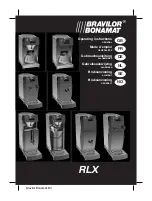
MOUNTING STEPS
The Inlet
1.
Use a pencil to mark the cutting hole size (155mm). Position close to the fire, but not in a position where it might draw in
smoke when the door is opened, i.e. about 1mtr away
2.
Before you cut be sure to check above the unit for a minimum clearance space of 350mm, and the location of the
ceiling joists. The white inlet body must fit freely in the hole.
3.
Turn the
4.
Finally, attach the ducting to the rear of the secure with provided ducting tape.
The Outlets
5.
Position the outlet vent mounting back in the room you have chosen and cut a 155mm hole.
**SEE PLACEMENT OF OUTLETS
6.
Before you cut be sure to check above the unit for a minimum clearance space of 300mm, and the location of the
ceiling joists. The fascia mounting back must fit freely in the hole
7.
Slide the outlet vent fascia mounting back into place and screw into place using the four 6x¾ pan head screws
provided. Press the fascia ring onto the body and then screw the centre diffuser into position
8.
In the ceiling cavity suspend the inline motor from the rafters. When fitting the ducting, ensure that the arrows on the
motor housing are pointing in the direction of the outlet vent.
There is a directional arrow on the main fan body showing the flow of air through the inline fan unit.
FINAL STEPS
Finally, connect the wiring as illustrated in the wiring diagram above.
Note:
Approximate means of disconnection are required to be incorporated in the fixed wiring. (Weiss Limited recommends
that a qualified electrician complete the electrical installation).
CLEANING AND MAINTANANCE
To clean the fascia, simply wash it by hand with a damp cloth and warm soapy water. Do not use abrasives or solvent
cleaners.
The fan unit needs to be wiped clean internally every 2 years to remove dust and residue from the fan blades and
motors
. Isolate the unit from the mains before cleaning.
LENGTH OF DUCT
Have the
Heat Transfer System
fan-to-room lengths as short as possible, if necessary an extra long inlet can be boosted by an
inline fan (Weiss FV05CP) wired back to the main fan terminals. Have the duct stretched out and as straight as possible. Be
sure to cut off any excess. Support duct and bends from the rafters as necessary.
**PLACEMENT OF OUTLET
Keep the outlet ducting lengths as short as possible - this increases efficiency. It is not necessary, to put outlet in the centre of
the room. The outlet vent needs only to be in the corner of the room.
Note:
It takes a while to heat a room and is dependent on humidity and on the moisture content of the furnishings. For warm
air to flow the system must be “open” i.e., doors open back to the inlet. The fire or heat source needs to be turned full up
.
Air
the house occasionally in fine weather. High studs, or badly insulated homes will remain more difficult to heat than low ceiling
–
well insulated homes.
OPTIONAL ACCESSORIES
This product has been designed to operate most efficiently with up to 9 metres of ducting.
If you require longer ducting, we recommend that you install the Weiss™ Inline fan unit (Cat No FV0
6
CP) along with a Weiss™
Insulated Ducting length
–
with joiner (Cat No FV63)
The optional Inline fan motor is best placed on the inlet side of the main fan.
QUESTIONS AND ANSWERS
Q
: Will the air from the outlet feel hot?
A
: It will depend on the available heat from the heat source. An outlet temperature of about 20ºC to 25ºC is common, but
this will not feel warm to your hand. Average skin temperature of your hand is 28-32ºC.
Q
: Do I use the thermostat supplied.
A
: A thermostat MUST always be used.
Q
: My house has a high stud / is badly insulated, will this product still work?
A
: Yes, but obviously not as well as in a well insulated low-stud home. It will always take longer to warm a large volume
room.




















